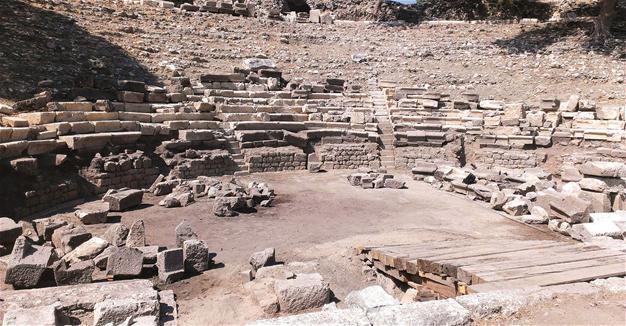Centuries-old rental agreement unearthed in Turkey’s İzmir
ANTALYA – Doğan News Agency

DHA photo
Excavations that are ongoing in the ancient city of Teos in İzmir’s Seferihisar have unearthed a 2,200-year-old inscription, thought to be the most comprehensive rental agreement in Anatolian history.
The agreement, which was apparently made with a guarantor and six witnesses, including the notables of the city, also declares punishments against the improper use of land containing buildings.
Professor Mustafa Adak, the head of Akdeniz University’s Prehistoric Languages and Cultures Department, said Heredotus provided information about the ancient Teos, which was established in 1,100.
“‘It is located in the world’s most mild place,’ Heredotus says about this city. It is currently within the borders of the Seferihisar district. Excavations were carried out in the 1960s but since 2010 work has continued under the leadership of Professor Musa Kadıoğlu, the head of the Ankara University Archaeology Department,” Adak said.
“Teos is one of the most productive cities in Anatolia in terms of the content of inscriptions. The administrative and regional structure of the city can be understood from the inscriptions, which give very detailed information about the Hellenistic and Roman eras. Some 200 inscriptions were taken from Teos up to 2010 and this doubled with our works. As of 2016, we have some 400 inscriptions,” he added.
A rental agreement “Among the inscriptions, one is particularly interesting, with quite rich content. An agreement was made on a 1.5-meter-long stela. It has lines. It is a detailed agreement. According to it, students of the Gymnasium between the age of 20 and 30 - called Neos - inherited from a person in Teos. This person donated his land, which included structures, slaves and the holy altar, to the Neos. In order to meet the expenses of this land and to get income, the Neos rented the land. The inscription tells us who owned the land in the past and what it includes. It also mentions a holy altar. The Neos express in the agreement that they want to use this holy place three days a year. In this period, the state collected tax from lands. But since the land was defined ‘holy,’ it was exempted from tax. It is understood that the land was rented at an auction and the name of the renter is written on the inscription,” Adak said.
“A guarantor was needed for the agreement. The names of the renter and his father were written in the agreement. Six witnesses were also necessary for this agreement to be valid, three of whom were the top administrators in the city,” he added.
Punishments “This inscription reveals the structure of the Gymnasium and that the Neos were able to own a property. This is first and only example in the ancient world. Almost half of the inscription is filled with punishment forms. If the renter gives damage to the land, does not pay the annual rent or does not repair the buildings, he will be punished. The Neos also vow to inspect the land every year,” said the Akdeniz University professor.
“There are two particularly interesting legal terms used in the inscription, which large dictionaries have not up to now included. Ancient writers and legal documents should be examined in order to understand these words mean,” Adak said.
He also added that the concept of citizenship was very important in the ancient age and people could become citizens at the age of 20 on condition that their parents were citizens.
“The Neos served as civil servants in politics and assemblies,” he said.
Social life and judicial system The head of the Teos excavations, Musa Kadıoğlu, said the inscriptions were unearthed in the western part of the site’s Dionysos temple.
“The inscription provides information about the social life and judicial system of Teos in the Hellenistic era,” Kadıoğlu added.
One of the 12 Ionian cities, Teos was examined by the British Society of Dilettanti in 1764, 1765 and 1862, by the French in 1924 and 1925, and by Ankara University academics Yusuf Boysal and Baki Öğün between 1962 and 1967, said Kadıoğlu.
In the second half of the 3rd century, the Ionia and Hellespontos Dionysos Artists Union, including poets, musicians theaters and singers, was formed in the city, he added.
“Some time later, this union was seen as a source of unrest in the city and they were sent to Ephesos [Ephesus] first and then to Myonnessos [Doğanbey] and Lebedos [Ürkmez]. The poets Anakreon, Antimakhos, Epikuros, Nausiphanes and Apellikon, and the historian Hekataios were important philosophers and artists who lived in Teos,” Kadıoğlu stated.
